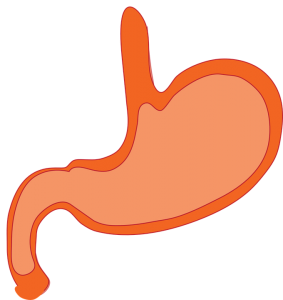 Over the teeth and through the gums, look out stomach here it comes! In last week’s blog we talked about digestion in the mouth. Now it’s on to the stomach!
Over the teeth and through the gums, look out stomach here it comes! In last week’s blog we talked about digestion in the mouth. Now it’s on to the stomach!
STOMACH
When swallowed food reaches the stomach, it is acted upon by gastric juices. Gastric juices are secreted by gastric glands in the stomach wall. These glands contain three main types of secretory cells: mucous cells, chief cells and parietal cells. The product of these three cells combine to create gastric juices.
Pepsin is the most important digestive enzyme in the stomach because it is responsible for protein digestion. Pepsin begins as hydrochloric acid when it is excreted by the chief cells but is converted to pepsin by a nonerosive enzyme precursor called pepsinogen (also secreted by the chief cells). The mucous cells contained in gastric juice secrete large quantities of thin mucus used to line and protect the stomach walls. This is important because pepsin is strong enough to digest the protein that creates the stomach wall. Mucosal cells also release histamine, which stimulates additional release of gastric juice. Lipase is another of the gastric juices. It is responsible for splitting fats. Lipase is primarily used as a buffer in the stomach, as the high acidity of the stomach inactivates much of its power. Gastric juice also contains intrinsic factor, which aids in the absorption of B-12. Intrinsic factor is secreted by the parietal cells. Parietal cells also secrete somatostatin to suppress the acid secretions if they get too high. The stomach will continue to release gastric juices until the stomach pH reaches 1.5. All contents combined create a mushy substance called chyme. As the chyme builds pressure against the pyloric sphincter (the valve between the stomach and the small intestine), it is slowly released into the small intestine for the next stage of digestion. It takes about 30 minutes for fruits to move through the stomach and into the small intestine, while it takes up to five or six hours for fats to finish processing. The stomach absorbs a little water, glucose, certain salts, alcohol and lipid soluble drugs, but most digestion and assimilation takes place in the small intestine.
NOTE: Cephalic action is the secretion of gastric juices because of a parasympathetic response from the sight, taste or smell of food. 30% – 50% of gastric juice is secreted because of cephalic action. This parasympathetic impulse is sent along the vagus nerve fiber. When the parasympathetic nerves give the signal that there is food around, the signal is sent to the stomach via the vagus nerve to release gastrin, a peptide hormone. In the presence of gastrin, the gastric cells produce more gastric juice. Gastrin, histamine and acetylcholine are all released to increase gastric juice secretion if the body senses there is not enough in the stomach. Gastrin is also released if the body senses a distention of the stomach wall (a sign of overeating or not chewing enough) knowing the extra food or the particles of food that were not chewed into small enough pieces will need extra acid to help dissolve them into the smallest particles possible. If particles are not broken down, the small intestine will not be able to assimilate the food.
Hiatal hernia
If you suffer pain in the stomach area (where the ribs meet in the center of your chest), a hiatal hernia should be suspected. I am not talking about something you need to do surgery on; surgery is never the answer for hiatal hernia. Diet correction and intestinal balance is. The stomach is naturally supposed to cradle toward the left side of the body at the end of the esophagus, but many times it works its way up into the esophagus or a weakening in the diaphragm muscle allows it to push up into the diaphragm. This will not happen unless the large intestine is dysfunctional and has begun to draw energy from the lungs so much so that the lungs become weakened as well. (The diaphragm is a lung-controlled muscle.) Symptoms of hiatal hernia include falling asleep when sitting (because the hernia is not allowing the diaphragm muscle to expand all the way), pain in the stomach after eating (due to the inflammation of the stomach and the inability to digest the contents), hiccoughs, burping and becoming “full” when you have only eaten small amounts of food (you can see that the stomach would not be able to hold as much if half of it is stuffed up into the esophagus or diaphragm). Angina, heart burn and reflux (acid indigestion) are primarily caused by hiatal hernia. Hiatal hernia is a symptom which comes from the colon’s inability to expel waste. The person suffering with hiatal hernia needs to do some good colon cleansing, then help the body with the digestion of food by food combining and/or correcting the digestive abilities of the stomach, liver and pancreas. If the person suffers with reflux or ileocecal valve problems (there is never reflux without having ileocecal valve weakness first), the same advice holds.
Suggestions to strengthen the stomach
- Eat more raw fruits and vegetables (118 degrees kills the enzyme action)
If the person has lots of longitude ridges on the fingernails, chances are they cannot absorb and digest nutrients, so steaming the vegetables is better than eating raw vegetables in this case because steamed vegetables are much easier to digest. (Not cooked – steamed for three minutes or until the outer fiber shell is soft).
- Fruit and cleansing foods are best as the first meal of the day.
- Make sure the bowels are evacuating well; well means at least once per meal eaten.
- The stomach-weak person should highly consider food combining.
